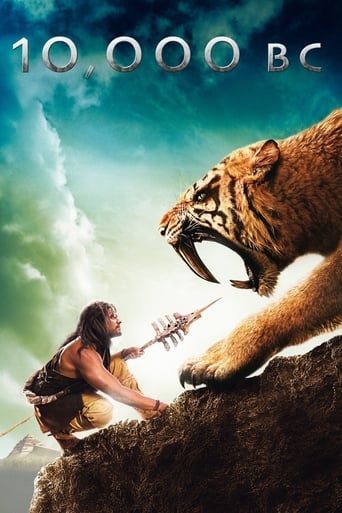

There is nothing like an old fashioned slave revolt story to get you cheering. The first time I saw this film I liked it except for the part about the pyramids. They weren't around then - or were they? It got me researching and it turns out we don't really know when they were built - one millenia is as good as another. The brillant idea of mammoths used in construction explains a lot - it kind of makes sense! However I wasn't looking for historical accuracy just some entertainment. As for them speaking English in the movie - I was glad for that to enabling understanding. I wouldn't begrudge them dubbing it in other languages in other countries. Great scenery but the CGI was so so on the second viewing.
... View MoreFirstly the acting was great. The landscapes were awesome. CGI maybe not the best in the history of cinematography but nonetheless very good. The story was very interesting, not the most complex so only people that read at least 10.000 books can understand, either way not the most simple one. It was right on point and it says enough so you can understand what is all about in that movie. Maybe the only complain which i would agree if i would have cared about the historical accuracy of what happened 10.000 years ago. I can understand that the history snobs get very triggered at a movie when it lacks in accuracy on historical part, but come on, do you really care about what happened 10000 years ago? I mean when a movie has a lot of inaccuracies in more recent events such as ww2 it's ok to complain, but in this case I feel like people are neatpicking. It wasn't perfect, but not how people describe it here, I feel like the grade that movie got does not fo the justice. Have a good day.
... View MoreCreating a period piece based upon the Stone Age is very dubious because little is well known about prehistoric times, even with some evidence like fossils and cave men drawings. Nevertheless it can be safely stated that Roland Emmerich's "10,000 BC" fails on many levels. And the problems go way beyond the historical blunders, which include Iron Age items (swords, cages, chains), pyramids, gilded metallic pyramid top, stirrups, fabric clothing/sails with bright colors, and copper telescope. Note that the Iron Age commenced only around 1200 BC; the Copper Age began around two thousand years or so earlier. We even see a fairly accurate early modern map of the western world, including eastern South America (!). Where did these ancients get the appropriate nautical instruments for map-making? Even domesticated woolly mammoths are shown restrained by iron chain in the DESERT heat. Could not the director use Computer Generated Imagery to create mastodons instead? Hey, you can't have everything! Anyway, it is nice to learn that folks had such full and white sets of teeth then, while some women had beautiful coiffed hair and skin without scars, cuts, and scratches (even after a grueling forced march). It was interesting to learn that the Africans dined on South American chili in 10,000 BC. Beyond these fantastic facts, the movie is problematic with odd language use (unnatural English) for the era. Another annoyance is the expression "white rain" for snow. One would think that early man had used a simple word for "snow" at it is a common occurrence among mountain people. Other problems include dreadful scripting, poor pacing, ill-timed editing, and unremarkable acting. The whole muddle would have been better known as a fantasy or dream.The film, which becomes more ludicrous as it progresses, is narrated throughout by Omar Sharif. A Yagahl mountain clan of woolly mammoth hunters ekes out a meager existence (to make some sense of location, maybe they inhabit the Mt. Ararat area in eastern Turkey). But as the narrator says, before long the tribe will morph into warriors. The main character, D'Leh (Steven Strait), is looked down upon by some as his late father was unfairly perceived as a coward. The kinfolk are attacked and pillaged by prehistoric Arabic-looking slavers on horseback while two dozen or so survivors are taken prisoner (including D'Leh's love, Evolet = Camilla Belle). D'Leh and three companions quickly assemble to track the invaders. They trudge across nearly impassable mountains and thick jungles and scorching deserts. But to obtain a few slaves the ancient Arabs certainly made a cost-prohibitive and long and arduous trek (coming and going), which seems to consume about half of the feature. Along the way people encounter three types of prehistoric mammals: (1) more woolly mammoths from the Cenozoic Era's Pleistocene Period, (2) Diatrymas (large flightless birds from the Eocene), and (3) a Pleistocene saber-toothed cat (Smilodon), whose upper canines are disproportionately large and so long that the poor animal can barely extent his lower jaw beyond them! Anyway, D'Leh frees the dangerous cat, who repays him by not eating him. Because he handled himself well with the Smilodon (known as "spear-tooth" by natives), D'Leh is acknowledged as leader of the growing expedition by the prehistoric black Africans. At trek's finale D'Leh observes a super-advanced civilization (very very early Egyptian) under a man-god who commands the building of pyramids. The ruling nobles are prehistoric Asiatic Indians. Despite his unifying of North African warriors, D'Leh realizes that he is still outnumbered. If only he can free the captive slaves working the pyramids! Will the captured slaves even help them? Guess. The CGI is passable, and the sweep shots of the pyramids are well done. A positive element is that the use of gratuitous violence is somewhat controlled. Not that there is no carnage, but the camera cuts do spare us the potential grisly segments. Would including these scenes improve the film? Well, go back and read the first paragraph. On a typically more negative note, the movie does present some strange quotes. Here are just three of them: "I understand your pain." "Don't forget to chew." 'Tell him I am older than I look."A defender of Director Emmerich may say that he creates movies to please crowds and make money for the major studios. While that may be, it is difficult to find those above adolescent age who would appreciate this preposterous mess. You may get through it if you do not care much about history. But it is recommended only for the incarcerated, intoxicated, deranged, and the drugged.
... View MoreAdmittedly, my memory of 10,000 B.C. is a bit unstable after watching it on HBO a few years ago. I remember the rudimentary plot - young warrior of woolly mammoth hunting tribe is predestined to save his azure-eyed girlfriend from a more advanced Egyptian-like race. I remember (I think) the opening shot of the mammoth hunt where the young warrior earns his stripes by standing his ground and holding a spear for a mammoth to impale itself upon. I remember the mammoth tribe's journey across several jumbled climate zones (grassland, jungle, desert) to retrieve the young woman, Evolet. I certainly remember the encounter with the carnivorous terror-birds (Phorusracos), one of the few exciting parts of the movie. I sorta remember a man from another tribe agreeing to help the young mammoth hunter (can't remember his name) in his quest. I remember the young hunter being trapped in some watery hole with an enormous saber-tooth cat and the hunter saying something hilariously to the effect, "I'll free you if you promise not to eat me". He frees the cat and the cat doesn't eat him. However, the sabertooth doesn't do much else in the movie. And, yeah, I remember, the Egyptian-like civilization using mammoths to construct their monuments and pyramids (actually not a bad touch).However, what I most remember is a physical impossibility - mammoths galloping like horses over the meadows. Now, like most elephants, mammoths would have managed at best a shuffling walk - pretty fast but no gallop. It was logical gaffes like this that actually made me realize what a junk heap of a movie 10,000 B.C. really is, if you stop to think about it. If you don't think about it, which I did for a while, it's a fairly entertaining pulp B-movie.
... View More